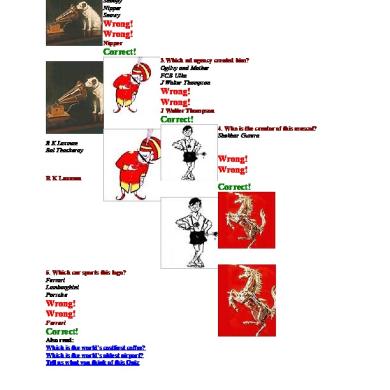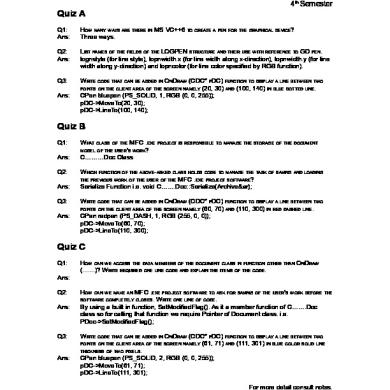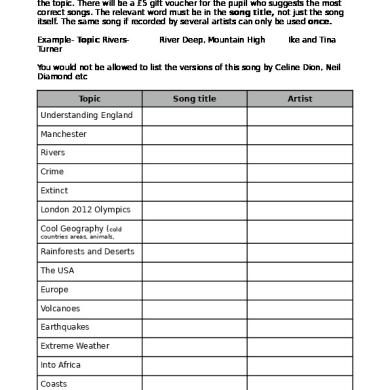Quiz 1.docx
This document was uploaded by user and they confirmed that they have the permission to share it. If you are author or own the copyright of this book, please report to us by using this DMCA report form. Report DMCA
Overview
Download & View Quiz 1.docx as PDF for free.
More details
- Words: 556
- Pages: 8
define la sílaba como "un elemento del habla que actúa como una unidad de ritmo, que consiste en una vocal, una consonante silábica o vocal / + combinación de consonantes ". Por otro lado, Hancock (2003: 50) cree que una sílaba se describe a menudo como un grupo de uno o más sonidos con un pico o núcleo. defines the syllable as " an element of speech that acts as
a unit of rhythm, consisting of a vowel, a syllabic consonant or vowel / + consonant combination ". On the other hand, Hancock (2003: 50) beliefs that a syllable is often described as a group of one or more sounds with a peak or nucleus.
Phonologically speaking, a syllable is defined as the way in which vowels and consonants combine to form various sequences ( the study of the location of sounds in sequence is called phonotactics) . Vowels can form a syllable on their own or they can be the " centre or nucleus " of a syllable , e.g. [e] in bed [b | ……………………(En términos fonológicos, una sílaba se define como la forma en que las vocales y las consonantes se combinan para formar varias secuencias (el estudio de la ubicación de los sonidos en secuencia se llaman fonotácticos). Las vocales pueden formar una sílaba por sí mismas o pueden ser el "centro o núcleo" de una sílaba, p. [e] en la cama)
SUPRAGMENTAL In this example, the English word "plant" consists of a single CCVCC syllable. This syllable has been broken up into its onset (any consonants preceding the vowel) and its rhyme (all phonemes from the vowel to the end of the syllable).
la estructura onset-nucleus-coda. The rhyme has been further divided into the nucleus, which in the vast majority of syllables is a vowel (the exceptions are syllabic consonants) and the coda, which are any consonants following the nucleus. The rhyme is the vowel plus(mas) cualquier any following consonants. 'plant'. Syllable is composed of an Onset = /pl/ and a Rhyme = /ænt/ The Suprasegmentals CVC – kick, dip, date, seat, did, kill, the, when, height, deep, fill, duel, sheet, hide, sheet, etc. where V stands (Representa) for vowel and C (Sgnifica) stands for consonant as previously observed. Final Position Consonant Clusters: oVCC – ant, and, arks, imp, its, ifs, eats, ink, kids, tenth, looked, sink, link, sits, keeps, sheets, leads, bags, can’t, bond, fifth, etc. VCCC – ants, inks, products, student, prudent, /stjudnt, prudnt/ etc.
VCCCC – students, prompts, exempts, texts, sixths, /teksts, siksșs/, thousandth, mulcts, sculpts, etc
Fall or rise in question tags? A fall is used when the speaker expects confirmation. A rise is used when the speaker expresses an element of doubt.
flounce:
onset =
/fl/
rhyme =
/aʊns/
nucleus = coda = free:
/aʊ/
/ns/
onset /fr/ rhyme = /iː/
nucleus = /iː/ coda zero each:
onset zero rhyme = /iːt͡ʃ/ nucleus = /iː/ coda = /t͡ʃ/
Clearly, an English syllable may accommodate more than one consonant, either at the initial position or the final position. This tendency for a syllable to have multiple consonants is regarded as a
clustering of consonants
Initial Position Consonant Clusters: o CCV – Examples : stop, pray, clay, fry, throw, blow, crow, plead, treat, etc. O CCCV – stray, strive, strap, sp ray, screw, split, strip, etc.
QUIZ 2
a unit of rhythm, consisting of a vowel, a syllabic consonant or vowel / + consonant combination ". On the other hand, Hancock (2003: 50) beliefs that a syllable is often described as a group of one or more sounds with a peak or nucleus.
Phonologically speaking, a syllable is defined as the way in which vowels and consonants combine to form various sequences ( the study of the location of sounds in sequence is called phonotactics) . Vowels can form a syllable on their own or they can be the " centre or nucleus " of a syllable , e.g. [e] in bed [b | ……………………(En términos fonológicos, una sílaba se define como la forma en que las vocales y las consonantes se combinan para formar varias secuencias (el estudio de la ubicación de los sonidos en secuencia se llaman fonotácticos). Las vocales pueden formar una sílaba por sí mismas o pueden ser el "centro o núcleo" de una sílaba, p. [e] en la cama)
SUPRAGMENTAL In this example, the English word "plant" consists of a single CCVCC syllable. This syllable has been broken up into its onset (any consonants preceding the vowel) and its rhyme (all phonemes from the vowel to the end of the syllable).
la estructura onset-nucleus-coda. The rhyme has been further divided into the nucleus, which in the vast majority of syllables is a vowel (the exceptions are syllabic consonants) and the coda, which are any consonants following the nucleus. The rhyme is the vowel plus(mas) cualquier any following consonants. 'plant'. Syllable is composed of an Onset = /pl/ and a Rhyme = /ænt/ The Suprasegmentals CVC – kick, dip, date, seat, did, kill, the, when, height, deep, fill, duel, sheet, hide, sheet, etc. where V stands (Representa) for vowel and C (Sgnifica) stands for consonant as previously observed. Final Position Consonant Clusters: oVCC – ant, and, arks, imp, its, ifs, eats, ink, kids, tenth, looked, sink, link, sits, keeps, sheets, leads, bags, can’t, bond, fifth, etc. VCCC – ants, inks, products, student, prudent, /stjudnt, prudnt/ etc.
VCCCC – students, prompts, exempts, texts, sixths, /teksts, siksșs/, thousandth, mulcts, sculpts, etc
Fall or rise in question tags? A fall is used when the speaker expects confirmation. A rise is used when the speaker expresses an element of doubt.
flounce:
onset =
/fl/
rhyme =
/aʊns/
nucleus = coda = free:
/aʊ/
/ns/
onset /fr/ rhyme = /iː/
nucleus = /iː/ coda zero each:
onset zero rhyme = /iːt͡ʃ/ nucleus = /iː/ coda = /t͡ʃ/
Clearly, an English syllable may accommodate more than one consonant, either at the initial position or the final position. This tendency for a syllable to have multiple consonants is regarded as a
clustering of consonants
Initial Position Consonant Clusters: o CCV – Examples : stop, pray, clay, fry, throw, blow, crow, plead, treat, etc. O CCCV – stray, strive, strap, sp ray, screw, split, strip, etc.
QUIZ 2
Related Documents

Quiz
November 2019 39
Quiz
May 2020 34
Quiz
November 2019 35
Quiz
May 2020 33
Quiz
October 2019 45
Quiz
November 2019 39More Documents from ""

Quiz 1.docx
May 2020 1
Mapas Conceptuales (1).docx
May 2020 2
Observation Classroom Management Plan.docx
May 2020 2

